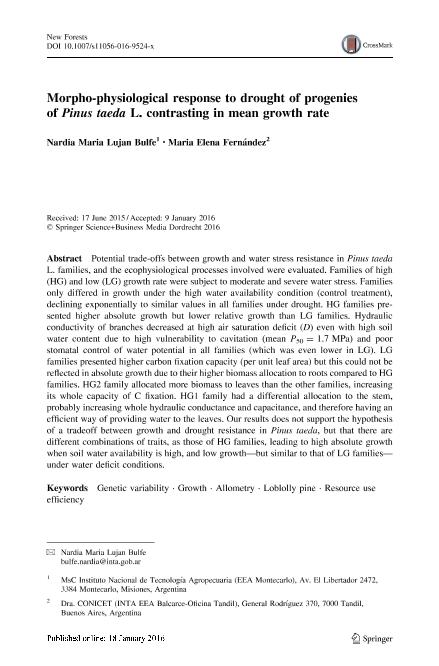Artículo
Morpho-physiological response to drought of progenies of Pinus taeda L. contrasting in mean growth rate
Fecha de publicación:
05/2016
Editorial:
Springer
Revista:
New Forests
ISSN:
0169-4286
Idioma:
Inglés
Tipo de recurso:
Artículo publicado
Clasificación temática:
Resumen
Potential trade-offs between growth and water stress resistance in Pinus taeda L. families, and the ecophysiological processes involved were evaluated. Families of high (HG) and low (LG) growth rate were subject to moderate and severe water stress. Families only differed in growth under the high water availability condition (control treatment), declining exponentially to similar values in all families under drought. HG families presented higher absolute growth but lower relative growth than LG families. Hydraulic conductivity of branches decreased at high air saturation deficit (D) even with high soil water content due to high vulnerability to cavitation (mean P50 = 1.7 MPa) and poor stomatal control of water potential in all families (which was even lower in LG). LG families presented higher carbon fixation capacity (per unit leaf area) but this could not be reflected in absolute growth due to their higher biomass allocation to roots compared to HG families. HG2 family allocated more biomass to leaves than the other families, increasing its whole capacity of C fixation. HG1 family had a differential allocation to the stem, probably increasing whole hydraulic conductance and capacitance, and therefore having an efficient way of providing water to the leaves. Our results does not support the hypothesis of a tradeoff between growth and drought resistance in Pinus taeda, but that there are different combinations of traits, as those of HG families, leading to high absolute growth when soil water availability is high, and low growth—but similar to that of LG families—under water deficit conditions.
Palabras clave:
Allometry
,
Genetic Variability
,
Growth
,
Loblolly Pine
,
Resource Use Efficiency
Archivos asociados
Licencia
Identificadores
Colecciones
Articulos(CCT - MAR DEL PLATA)
Articulos de CTRO.CIENTIFICO TECNOL.CONICET - MAR DEL PLATA
Articulos de CTRO.CIENTIFICO TECNOL.CONICET - MAR DEL PLATA
Citación
Bulfe, Nardia Maria Lujan; Fernandez, Maria Elena; Morpho-physiological response to drought of progenies of Pinus taeda L. contrasting in mean growth rate; Springer; New Forests; 47; 3; 5-2016; 431-451
Compartir
Altmétricas




